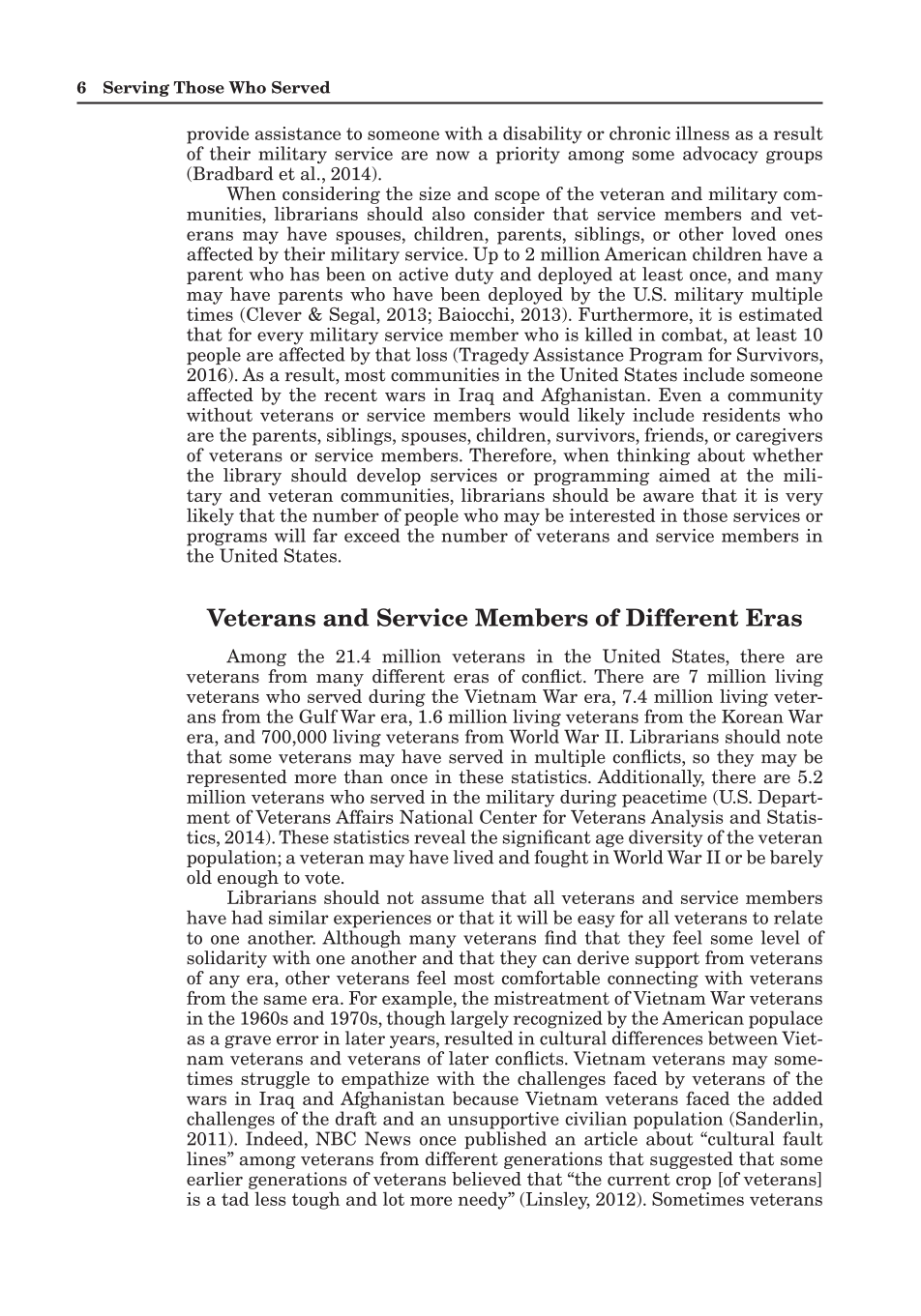6 Serving Those Who Served
provide assistance to someone with a disability or chronic illness as a result
of their military service are now a priority among some advocacy groups
(Bradbard et al., 2014).
When considering the size and scope of the veteran and military com-
munities, librarians should also consider that service members and vet-
erans may have spouses, children, parents, siblings, or other loved ones
affected by their military service. Up to 2 million American children have a
parent who has been on active duty and deployed at least once, and many
may have parents who have been deployed by the U.S. military multiple
times (Clever & Segal, 2013; Baiocchi, 2013). Furthermore, it is estimated
that for every military service member who is killed in combat, at least 10
people are affected by that loss (Tragedy Assistance Program for Survivors,
2016). As a result, most communities in the United States include someone
affected by the recent wars in Iraq and Afghanistan. Even a community
without veterans or service members would likely include residents who
are the parents, siblings, spouses, children, survivors, friends, or caregivers
of veterans or service members. Therefore, when thinking about whether
the library should develop services or programming aimed at the mili-
tary and veteran communities, librarians should be aware that it is very
likely that the number of people who may be interested in those services or
programs will far exceed the number of veterans and service members in
the United States.
Veterans and Service Members of Different Eras
Among the 21.4 million veterans in the United States, there are
veterans from many different eras of conflict. There are 7 million living
veterans who served during the Vietnam War era, 7.4 million living veter-
ans from the Gulf War era, 1.6 million living veterans from the Korean War
era, and 700,000 living veterans from World War II. Librarians should note
that some veterans may have served in multiple conflicts, so they may be
represented more than once in these statistics. Additionally, there are 5.2
million veterans who served in the military during peacetime (U.S. Depart-
ment of Veterans Affairs National Center for Veterans Analysis and Statis-
tics, 2014). These statistics reveal the significant age diversity of the veteran
population; a veteran may have lived and fought in World War II or be barely
old enough to vote.
Librarians should not assume that all veterans and service members
have had similar experiences or that it will be easy for all veterans to relate
to one another. Although many veterans find that they feel some level of
solidarity with one another and that they can derive support from veterans
of any era, other veterans feel most comfortable connecting with veterans
from the same era. For example, the mistreatment of Vietnam War veterans
in the 1960s and 1970s, though largely recognized by the American populace
as a grave error in later years, resulted in cultural differences between Viet-
nam veterans and veterans of later conflicts. Vietnam veterans may some-
times struggle to empathize with the challenges faced by veterans of the
wars in Iraq and Afghanistan because Vietnam veterans faced the added
challenges of the draft and an unsupportive civilian population (Sanderlin,
2011). Indeed, NBC News once published an article about “cultural fault
lines” among veterans from different generations that suggested that some
earlier generations of veterans believed that “the current crop [of veterans]
is a tad less tough and lot more needy” (Linsley, 2012). Sometimes veterans








































































































































































































